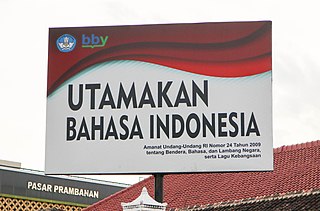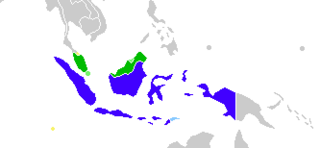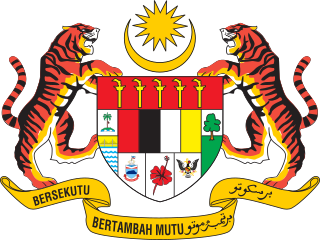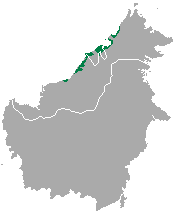Related Research Articles

Indonesian is the official and national language of Indonesia. It is a standardized variety of Malay, an Austronesian language that has been used as a lingua franca in the multilingual Indonesian archipelago for centuries. With over 280 million inhabitants, Indonesia ranks as the fourth most populous nation globally. According to the 2020 census, over 97% of Indonesians are fluent in Indonesian, making it the largest language by number of speakers in Southeast Asia and one of the most widely spoken languages in the world. Indonesian vocabulary has been influenced by various native regional languages such as Javanese, Sundanese, Minangkabau, Balinese, Banjarese, and Buginese, as well as by foreign languages such as Arabic, Dutch, Portuguese, and English. Many borrowed words have been adapted to fit the phonetic and grammatical rules of Indonesian, enriching the language and reflecting Indonesia's diverse linguistic heritage.

Malay is an Austronesian language that is an official language of Brunei, Malaysia, and Singapore. Indonesian, a standardized Malay-based national variety, is the official language of Indonesia and is one of working languages in East Timor. Malay is also spoken as a regional language of ethnic Malays in Indonesia and the southern part of Thailand. Altogether, it is spoken by 290 million people across Maritime Southeast Asia.

Malaysian Malay or Malaysian – endonymically within Malaysia as Standard Malay or simply Malay – is a standardized form of the Malay language used in Malaysia and also used in Brunei Darussalam and Singapore. Malaysian Malay is standardized from the Johor–Riau dialect of Malay, particularly a branch spoken in the state of Johor south of the Malay Peninsula. It is spoken by much of the Malaysian population, although most learn a vernacular Malay dialect or another native language first.
Indonesian and Malaysian Malay are two standardised varieties of the Malay language, the former used officially in Indonesia and the latter in Brunei, Malaysia and Singapore. Both varieties are generally mutually intelligible, yet there are noticeable differences in spelling, grammar, pronunciation and vocabulary, as well as the predominant source of loanwords. The differences can range from those mutually unintelligible with one another, to those having a closer familial resemblance. The regionalised and localised varieties of Malay can become a catalyst for intercultural conflict, especially in higher education.

The Kedayan are an ethnic group residing in Brunei, Federal Territory of Labuan, southwest of Sabah, and north of Sarawak on the island of Borneo. According to the Language and Literature Bureau of Brunei, the Kedayan language is spoken by about 30,000 people in Brunei, and it has been claimed that there are a further 46,500 speakers in Sabah and 37,000 in Sarawak. In Sabah, the Kedayan mainly live in the southern districts of Sipitang and Beaufort, where they are counted as a part of the local Malay populace. Whilst in Sarawak, the Kedayans mostly reside in the towns of Lawas, Limbang and Miri.

The prime minister of Brunei is the head of government of Brunei. Concurrently, the title is held by the sultan of Brunei, who as sultan is also the head of state of the country. The prime minister, minister of foreign affairs, minister of finance and economy, and minister of defence are all the Sultan of Brunei. He is Brunei's Supreme Executive Authority in his capacity as the Sultan and Yang Di-Pertuan. The Privy Council, the Council of Succession, the Religious Council, the Council of Cabinet Ministers, and the Legislative Council support him in carrying out his responsibilities.

Malay was first used in the first millennia known as Old Malay, a part of the Austronesian language family. Over a period of two millennia, Malay has undergone various stages of development that derived from different layers of foreign influences through international trade, religious expansion, colonisation and developments of new socio-political trends. The oldest form of Malay is descended from the Proto-Malayo-Polynesian language spoken by the earliest Austronesian settlers in Southeast Asia. This form would later evolve into Old Malay when Indian cultures and religions began penetrating the region, most probably using the Kawi and Rencong scripts, some linguistic researchers say. Old Malay contained some terms that exist today, but are unintelligible to modern speakers, while the modern language is already largely recognisable in written Classical Malay of 1303 CE.

Greater Indonesia was an irredentist political concept that sought to bring the so-called Malay race together, by uniting the territories of the Dutch East Indies with British Malaya and British Borneo. It was espoused by students and graduates of Sultan Idris Training College for Malay Teachers in the late 1920s, and individuals from Sumatra and Java, including Mohammad Natsir and Sukarno, on 28 September 1950. Indonesia Raya was adopted as the name of what later became the Indonesian national anthem in 1924.

The Ministry of Education is a ministry of the Government of Malaysia that is responsible for education system, compulsory education, pre-tertiary education, technical and vocational education and training (TVET), curriculum standard, textbook, standardised test, language policy, translation, selective school, comprehensive school.

The Banjar or Banjarese is an Austronesian language predominantly spoken by the Banjarese—an indigenous ethnic group native to Banjar regions— in the southeastern Kalimantan of Indonesia. The Banjarese language is the de facto lingua franca for various indigenous community especially in South Kalimantan, as well as Central Kalimantan and East Kalimantan in general.
The modern Malay and Indonesian alphabet consists of the 26 letters of the ISO basic Latin alphabet. It is the more common of the two alphabets used today to write the Malay language, the other being Jawi. The Latin Malay alphabet is the official Malay script in Indonesia, Malaysia and Singapore, while it is co-official with Jawi in Brunei.
The Writers' Movement '50, better known as Asas '50, is the first and oldest literary association in post-war in Singapore. It was founded on 6 August 1950, with a stated philosophy of "Art for Society".

The Brunei Malay, also called Bruneian Malay, is the most widely spoken language in Brunei Darussalam and a lingua franca in some parts of Sarawak and Sabah, such as Labuan, Limbang, Lawas, Sipitang, and Papar. Though Standard Malay is promoted as the official national language of Brunei, Brunei Malay is socially dominant and it is currently replacing the minority languages of Brunei, including the Dusun and Tutong languages, existing in a diglossic speech, wherein Brunei Malay is commonly used for daily communication, coexisting with the aforementioned regional languages and Malay creoles, and standard Malay used in formal speech; code switching between standard Malay and Brunei Malay is spoken in informal speech as a lingua franca between Malay creoles and regional languages. It is quite similar to Standard Malay to the point of being almost mutually intelligible with it, being about 84% cognate with standard Malay. Standard Malay is usually spoken with Brunei pronunciation.
The Tutong language, also known as Basa Tutong, is a language spoken by approximately 17,000 people in Brunei. It is the main language of the Tutong people, the majority ethnic group in the Tutong District of Brunei.
This article explains the phonology of Malay and Indonesian based on the pronunciation of Standard Malay, which is the official language of Brunei and Singapore, "Malaysian" of Malaysia, and Indonesian the official language of Indonesia and a working language in Timor Leste. There are two main standards for Malay pronunciation, the Johor-Riau standard, used in Brunei and Malaysia, and the Baku, used in Indonesia and Singapore.
Bacan Malay or Bacan is a Malayic language spoken on the island of Bacan in North Maluku province, Indonesia, by the minor Bacan ethnic group. It is an anomalous presence in the region, being surrounded by genetically distant Austronesian languages and languages of the unrelated North Halmahera family. Bacan is geographically removed from the Malay heartlands in the western archipelago.
MBIM may refer to:

Pengiran Muhammad Yusuf bin Pengiran Haji Abdul Rahim, pen name Yura Halim, was a Bruneian nobleman, politician, civil servant, diplomat, and writer. He served as the Menteri Besar of Brunei from 1967 to 1972. He wrote the lyrics for Brunei's national anthem, "Allah Peliharakan Sultan," in 1947. The song was adopted as the country's official national anthem in 1951, when it was still a British protectorate. He was longtime member of the Legislative Council of Brunei, serving on the council until his death in 2016.

The Ministry of Education is a cabinet-level ministry in the government of Brunei which oversees education in the country. It was established immediately upon Brunei's independence on 1 January 1984. It is currently led by a minister and the incumbent is Romaizah Mohd Salleh who took office since 7 June 2022. The ministry is headquartered in Bandar Seri Begawan.

Mohammad Jamil Al-Sufri bin Umar, pen name Wijaya, was a Bruneian aristocrat, historian and teacher who served as a member of the Royal Council, member of the Royal Succession Council, member of the Islamic Religious Council, and member of the Privy Council. He has also been referred to as the National Historian. He wrote works on the country's history, ancestry, customs and traditions, royal titles, Malay Islamic Monarchy (MIB), education, writings on Brunei heroes, and other topics.
References
- ↑ "Majalah Pusat, Rampak Serantau, Buletin Mabbim". Badan Pengembangan dan Pembinaan Bahasa. Kementerian Pendidikan, Kebudayaan, Riset dan Teknologi Republik Indonesia. 2022. Retrieved 19 December 2022.